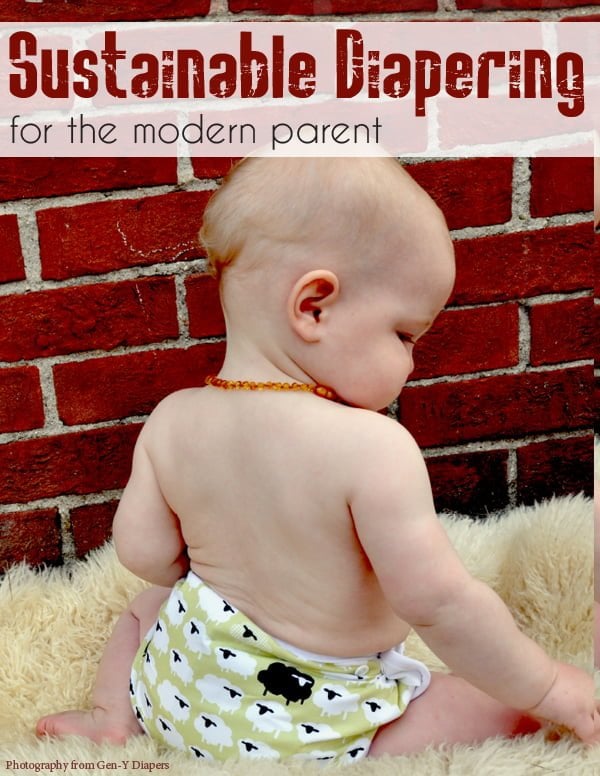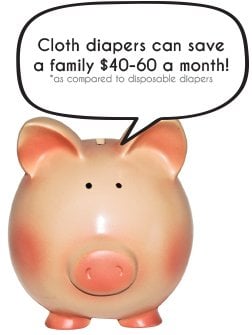Sustainable Diapering Options for the Modern Parent
 The average baby goes through 12 or more diapers every day of their life from birth through potty training (around 2-4 years of age).
The average baby goes through 12 or more diapers every day of their life from birth through potty training (around 2-4 years of age).
In America, most of those diapers are in the form of disposable diapers that are thrown out with the weekly garbage destined to sit in a landfill for an estimated 500 or more years. In addition to their environmental impact, disposable diapers contain potentially toxic chemicals.
These toxic chemicals are placed next to your baby’s delicate skin for almost 24 hours a day. There are healthier and more sustainable options to consider; many of which can save you thousands of dollars.
Sustainable Disposable Diapers
Eco-friendly disposables are slightly more sustainable than regular disposable diapers but they are still disposable. Depending on the brand, they can be free of chlorine processing (bleaching), fragrance free, or latex free but they still contain some synthetic materials. These diapers may be healthier for your baby but they will still sit in landfills for hundreds of years before they degrade (if ever). Beware of brands that say they are biodegradable or compostable because these processes only happen under specific conditions that won’t happen in a landfill.
Modern Cloth Diapers
Cloth diapers have come a long way since prefolds, pins and plastic pants. While prefolds and covers are still a very popular and economical option for parents today, the modern cloth diaper options are much more appealing. The modern cloth diapers are just as easy to use as a disposable diaper–but with Velcro or snap closures. Modern cloth diapers come in many different varieties, are available at any price range, and have a color selection larger than a rainbow. Some styles and fabrics are more sustainable than others, but they are all reusable for many years.
While many cloth diapers today are made with synthetic fibers, plastic snaps and polyurethane laminate (PUL for waterproofing fabric), diapers made from natural fibers are much more sustainable. Prefold and flat diapers are commonly made with organic cotton, hemp and bamboo blends. Wool can be used over prefolds and flats as a waterproof diaper cover and come in very fashionable styles like longies, shorties and covers.
Many parents consider cloth diapers for economic reasons and find ways to diaper their baby for free using found fabrics. Almost any absorbent material can actually be used as a diaper. T-shirts, kitchen towels and receiving blankets can be folded, cut or sewn together to make an upcycled baby diaper. Old wool sweaters can be sewn into diaper covers. These options are great for parents who are environmentally friendly but can also be helpful for families struggling to afford diapers for their baby.
Elimination Communication
The practice of elimination communication (commonly referred to as EC) is not a new concept, but it became popular again in 2001 with the book Diaper Free! The Gentle Wisdom of Natural Infant Hygiene by Ingrid Bauer.
Elimination communication is by far the most sustainable diapering option but not always the most practical. It involves following your baby’s cues and signals to know when your baby has to relieve herself. When you learn to recognize these cues your baby can be placed on a toilet or potty chair to pee and poop. With prefolds, diaper belts and split pants your baby doesn’t have to be naked all day to practice elimination communication.
Diaper belts, like these from EC Wear, make diaper removal quick & easy, minimizing baby’s discomfort and making it easier to offer opportunities to use the potty.
Sustainability Vs. Convenience
As with some of the other choices you make when living a sustainable lifestyle, the question of convenience always comes up.
Our modern society is very busy and parents like convenience. The joy of being a parent is that you get to set your own standards. Some parents can be extremely committed to the environment and practice elimination communication from birth through potty training, while others use a combination of both disposables and cloth diapers.
Your diapering decisions can be part-time or full-time and even if you are only changing three cloth diapers a day you can still reduce your baby’s environmental foot bum- print.
Also keep in mind that reusable options mean saving money—less hours worked to earn disposables and also less time spent purchasing them.
The Water Debate
 The average cloth diapering family washes one load of cloth diapers every 3-4 days. At 20-40 gallons of water per load (depending on your machine) that may sound like a lot of water, but the production of disposable diapers uses 2.3 times more water.
The average cloth diapering family washes one load of cloth diapers every 3-4 days. At 20-40 gallons of water per load (depending on your machine) that may sound like a lot of water, but the production of disposable diapers uses 2.3 times more water.
While it is a legitimate concern, especially in parts of the country that suffer from droughts, you have to also look at other environmental benefits of cloth diapering in order to offset the use of water. To offset your water usage even more, consider a high efficiency washing machine and line drying your diapers.
By using cloth diapers you are saving energy, fuel, and petroleum that are used to produce disposable diapers. An independent study found that “on a per-diaper-change basis, manufacturing of single-use diapers require nearly six times the amount of energy used in manufacturing reusable diapers.”
In addition to resources, you are also preventing approximately one ton of garbage from being disposed of in the landfill (if choosing cloth diapers full time).
